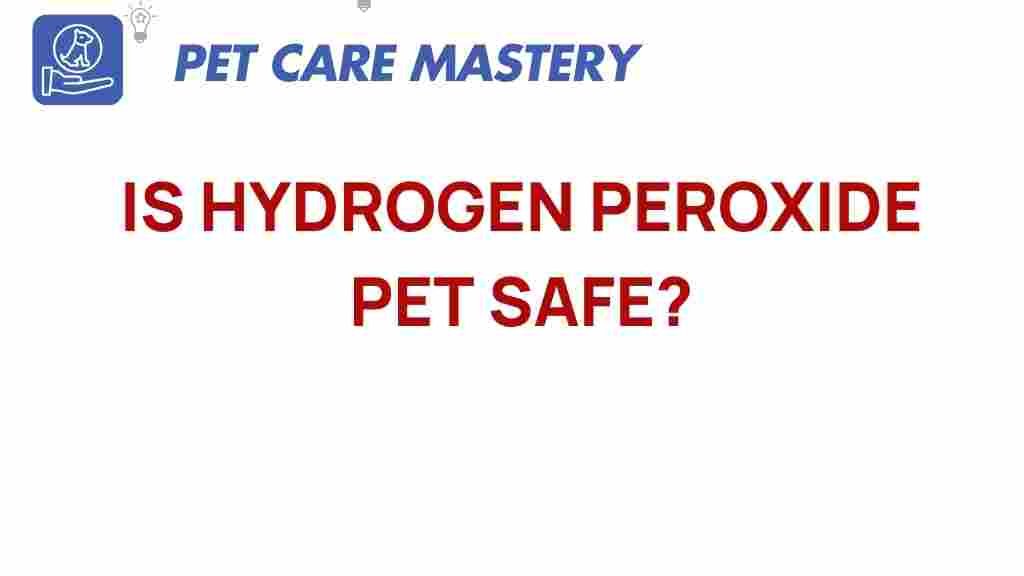Is Hydrogen Peroxide Pet Safe? Uncover the Truth Behind Its Use
As pet owners, we always strive to provide a safe and healthy environment for our furry companions. One common product that often raises questions is hydrogen peroxide. While it’s widely used for various cleaning and disinfecting purposes, it’s essential to understand its implications for pets. This article uncovers the truth about hydrogen peroxide’s safety for pets, outlining its potential benefits and risks, as well as how to use it properly.
Understanding Hydrogen Peroxide
Hydrogen peroxide is a chemical compound with the formula H2O2. It appears as a colorless liquid and is known for its antiseptic, bleaching, and oxidizing properties. Commonly found in households, its concentrations can range from 3% to 35%, with the lower concentrations being safer for various applications.
Common Uses of Hydrogen Peroxide
- Disinfecting wounds
- Cleaning surfaces
- Whitening laundry
- Removing stains
- Eliminating odors
Is Hydrogen Peroxide Safe for Pets?
The safety of hydrogen peroxide for pets largely depends on its concentration, the method of application, and the individual pet’s health condition. Here are some key points to consider:
1. Wound Cleaning
Low concentrations of hydrogen peroxide (typically around 3%) can be used to clean minor cuts and scrapes on pets. However, it’s crucial to use it cautiously:
- Apply a small amount to the wound.
- Use a cotton ball or gauze for application.
- Limit use to avoid damaging healthy tissue.
2. Inducing Vomiting
In some emergency situations, veterinarians may recommend using hydrogen peroxide to induce vomiting in dogs who have ingested something toxic. This should only be done under veterinary guidance and using the correct dosage:
- Generally, 1 teaspoon per 5 pounds of body weight is recommended.
- Do not exceed 3 tablespoons, regardless of the pet’s weight.
3. Cleaning Pet Accessories
Hydrogen peroxide can be effective for disinfecting pet gear, such as toys and bowls. It’s important to rinse thoroughly after cleaning to prevent any residue that could harm your pet.
Risks of Using Hydrogen Peroxide on Pets
While hydrogen peroxide can be beneficial, there are several risks associated with its use:
1. Toxicity
Higher concentrations of hydrogen peroxide (above 3%) can be toxic to pets. Ingesting concentrated solutions can lead to gastrointestinal distress, including:
- Vomiting
- Diarrhea
- Abdominal pain
2. Skin Irritation
Some pets may experience skin irritation from hydrogen peroxide. Always perform a patch test before applying it to larger areas of the skin. If you notice any redness or discomfort, discontinue use immediately.
3. Respiratory Issues
Inhaling the fumes of hydrogen peroxide can cause respiratory issues in pets, particularly in those with pre-existing conditions. Always ensure adequate ventilation when using it in enclosed spaces.
Step-by-Step Guide: Safe Use of Hydrogen Peroxide on Pets
Here is a step-by-step guide for safely using hydrogen peroxide with pets:
Step 1: Consult Your Veterinarian
Before using hydrogen peroxide for any purpose, consult your veterinarian, especially if your pet has existing health issues or is on medication.
Step 2: Choose the Right Concentration
Always opt for a 3% solution for pets. Higher concentrations should be avoided unless specifically directed by a veterinarian.
Step 3: Perform a Patch Test
Before applying hydrogen peroxide to a larger area, test a small patch of skin to check for any adverse reactions.
Step 4: Use Proper Application Techniques
- For wound cleaning, use a cotton ball or gauze.
- For inducing vomiting, administer the recommended dosage carefully.
Step 5: Monitor Your Pet
After using hydrogen peroxide, keep an eye on your pet for any signs of distress or adverse reactions. If you notice anything unusual, contact your veterinarian immediately.
Troubleshooting Tips
If you encounter issues when using hydrogen peroxide with your pet, consider the following troubleshooting tips:
1. If Your Pet Ingests Hydrogen Peroxide
If your pet accidentally ingests a concentrated solution, contact your veterinarian or an emergency animal poison control hotline immediately.
2. If Your Pet Shows Signs of Irritation
Should your pet exhibit signs of skin irritation (redness, swelling), wash the area gently with water and discontinue the use of hydrogen peroxide. Seek veterinary advice if necessary.
3. If Vomiting Does Not Occur
If you are using hydrogen peroxide to induce vomiting and it does not occur within 15 minutes, consult your veterinarian for further guidance.
Alternative Solutions for Pet Care
If you are hesitant to use hydrogen peroxide on your pet, consider these alternative options:
- Saline solution: Effective for cleaning wounds without the harshness of hydrogen peroxide.
- Commercial pet-safe disinfectants: Formulated specifically for pet environments.
- Consulting your veterinarian: They can provide safe alternatives based on your pet’s specific needs.
Conclusion
In summary, hydrogen peroxide can be safe for pets when used cautiously and in low concentrations. It offers benefits in wound cleaning and can be a useful tool in emergencies. However, it’s essential to understand the risks involved and consult your veterinarian before use. Always monitor your pet for any adverse reactions and consider alternative solutions if you have concerns about using hydrogen peroxide.
For further reading on pet safety, visit the ASPCA’s website. If you have specific questions about your pet’s health, always reach out to your veterinarian for tailored advice.
This article is in the category Health and created by PetCareMastery Team

1 thought on “Is Hydrogen Peroxide Pet Safe? Uncover the Truth Behind Its Use”